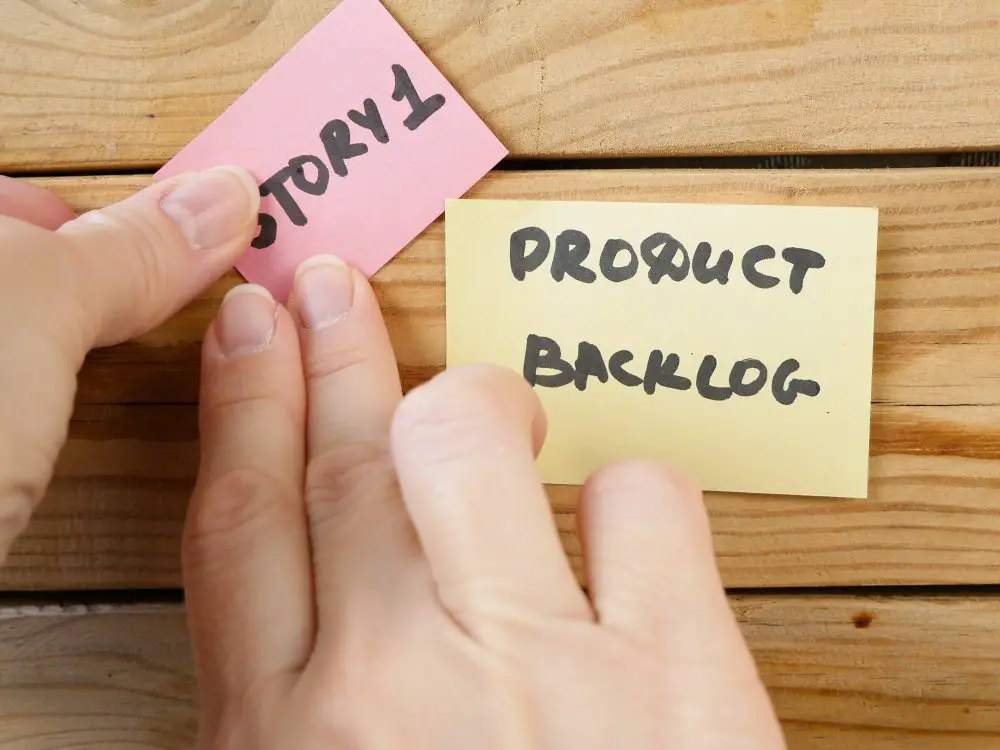Keeping Agile projects organized can be tough. Prioritizing tasks and focusing on critical items often prove challenging. Our Agile Product Backlog Template offers a solution to these common hurdles.
This powerful tool streamlines sprint planning and improves backlog grooming. It captures features, user stories, and requirements in a structured, centralized format. This approach enhances overall backlog refinement.
Our template simplifies task prioritization and estimation. Teams can quickly identify high-priority items and potential roadblocks. It includes all project work, covering product backlogs and sprints.
The Scrum backlog template in Jira Software boosts team productivity. It helps deliver incremental results within focused task sets. Visual Scrum boards improve task management and organization.
Key Takeaways
- The Agile Product Backlog Template captures features and information consistently.
- It simplifies task prioritization, helping teams identify dependencies and roadblocks quickly.
- The template includes all project work, accommodating various aspects and focus areas.
- Teams using the Scrum backlog in Jira Software experience increased productivity.
- Visual Scrum boards improve task management, leading to quicker project delivery.
What is an Agile Product Backlog Template?
An Agile product backlog template is a vital tool in Agile project management. It helps teams organize and track features, enhancements, and tasks throughout development. This structured document prioritizes work effectively, ensuring efficient project progress.

Understanding the Agile Methodology
Agile is an iterative approach to software development. It breaks projects into smaller, manageable phases called sprints. This method allows teams to adapt quickly and improve processes continuously.
Agile focuses on delivering value to the customer. By prioritizing key items, teams work on features that impact users most. This ensures the highest value is always delivered.
Key Components of an Agile Product Backlog
A well-structured Agile product backlog template includes several key components. These help teams manage their work effectively. The main elements are:
- User stories: Short, simple descriptions of a feature or functionality told from the perspective of the end-user.
- Acceptance criteria: Clearly defined conditions that must be met for a user story to be considered complete.
- Story points or effort estimates: A relative measure of the complexity and effort required to complete a user story.
- Priority ranking: A system for prioritizing user stories based on their importance and value to the customer.
The product backlog is a living document that evolves throughout the development process. As new requirements emerge or priorities shift, the backlog should be updated to reflect these changes.
The Agile product backlog template may include additional information. This can cover the sprint backlog and product roadmap. The sprint backlog contains user stories for a specific sprint.
The product roadmap provides a high-level overview. It outlines the product’s direction and long-term goals. These elements help teams plan and execute effectively.
| Backlog Component | Description |
|---|---|
| User Stories | Short, simple descriptions of a feature or functionality told from the perspective of the end-user. |
| Acceptance Criteria | Clearly defined conditions that must be met for a user story to be considered complete. |
| Story Points or Effort Estimates | A relative measure of the complexity and effort required to complete a user story. |
| Priority Ranking | A system for prioritizing user stories based on their importance and value to the customer. |
Understanding these key components is crucial for effective product backlog management. Teams can optimize their sprints by using this knowledge. This leads to high-quality software that meets user needs.
Benefits of Using an Agile Product Backlog Template
An agile product backlog template offers many advantages for project management teams. It streamlines workflows, enhances team collaboration, and boosts overall productivity. Let’s explore the key benefits of this powerful tool.
Improved Organization and Prioritization
The template provides a central location to manage all product requirements and tasks. Teams can focus on delivering the most valuable features first. This ensures the product aligns with customer needs and business goals.
GoodDay’s Product Backlog Template offers list and board views for easy navigation. Custom fields allow detailed item descriptions. These features make sprint planning and resource allocation more effective.
Enhanced Collaboration and Communication
The template fosters team collaboration and communication. It provides a shared platform for all stakeholders to access and update information. This ensures everyone understands project priorities and progress.
Team members can add comments, attach files, and assign tasks to specific individuals. This promotes open communication and reduces misunderstandings. It also creates a culture of teamwork and accountability.

Increased Efficiency and Productivity
An agile product backlog template boosts efficiency and productivity within project teams. It maintains a single list of prioritized items, reducing scattered documentation. Teams can quickly identify and address high-priority tasks.
The template integrates seamlessly with other agile processes, like sprint planning. This alignment optimizes team capacity and resources. As a result, high-quality products are delivered faster.
| Benefit | Description |
|---|---|
| Multiple Views | The GoodDay Product Backlog Template offers list and board views for easy comprehension and navigation. |
| Customization Options | Custom fields like Category and Effort allow for detailed item descriptions, facilitating effective sprint planning. |
| Task Tracking | Different task statuses, such as New, Under Review, Committed, In Progress, On Hold, Closed, and Cancelled, enable effective backlog management and prioritization. |
| Stakeholder Collaboration | The template caters to various stakeholders, including product owners, scrum masters, and product managers, promoting collaboration and continuous backlog refinement. |
An agile product backlog template improves project management processes. It creates a collaborative environment for teams. This leads to high-quality products that meet customer expectations and drive business success.
How to Create an Effective Agile Product Backlog Template
An effective Agile product backlog template is vital for successful project management. It helps optimize sprints and deliver customer value. Let’s explore the key steps in crafting a powerful backlog template.
Defining User Stories and Requirements
Well-defined user stories form the foundation of an Agile product backlog. They capture requirements from the customer’s perspective, focusing on desired functionality and value.
Writing user stories benefits from a template. It should outline the user role, desired action, and benefit. Here’s an example of structuring user stories in a spreadsheet-based product backlog:
| As a | I want to | So that |
|---|---|---|
| Customer | Search for products by category | I can easily find items of interest |
| Admin | View sales reports | I can track revenue and make informed decisions |
This format clearly communicates requirements and aligns the backlog with customer needs.
Prioritizing Tasks and Features
After defining user stories, prioritize tasks and features in the product backlog. This involves the product owner, stakeholders, and development team. Consider business value, dependencies, and risk when determining implementation order.
Continuous refinement and adjustment of priorities ensure the team focuses on delivering valuable features first.

Estimating Effort and Complexity
Accurate estimation is crucial for effective sprint planning and resource allocation. Include fields for estimating task effort in your product backlog template. Use techniques like story points or ideal days to gauge complexity.
Involve the development team in estimation to leverage their expertise and ensure realistic projections.
“Effective requirement gathering and task estimation are key to creating a comprehensive and actionable product backlog.”
Select high-priority items that fit within the upcoming sprint’s capacity. This becomes your sprint backlog, guiding the team’s focus for the iteration. Regular grooming maintains a clear roadmap and adapts to changing requirements.
A well-structured Agile product backlog template streamlines project management and enhances collaboration. It helps deliver value to customers efficiently. Embrace this powerful tool and watch your sprints thrive!
Best Practices for Managing Your Agile Product Backlog Template
Effective agile product backlog templates need best practices. These promote teamwork, communication, and efficient project management. Following these practices keeps your backlog organized and aligned with sprint goals.
Regular backlog grooming is crucial for management. It involves reviewing, updating, and prioritizing items in your backlog. Teams should add new stories and re-evaluate existing ones during these sessions.
They should also break down large stories into smaller tasks. A survey shows 70% of teams use backlog templates for planning. This shows how important this practice is.
Regular Backlog Grooming and Refinement
Hold backlog grooming sessions before each sprint planning meeting. This keeps your backlog clean and up-to-date. It ensures high-priority items are always at the top.
Constant refining helps avoid common challenges. These include overloaded backlogs, aged items, and incomplete definitions. Use prioritization techniques like MoSCoW or Kano models during grooming.
These help determine each item’s importance. They aid in deciding what to include in upcoming sprints. They also help choose what to defer to later iterations.

Aligning Backlog with Sprint Goals
Align your product backlog with sprint goals. Each sprint should have a clear objective. Sprint backlog items should contribute to achieving that goal.
Focus on the most valuable and relevant items. This ensures your team works on high-priority tasks. Consider these factors when selecting items for a sprint:
- Business value: Does the item deliver significant value to the customer or the organization?
- Dependencies: Are there any dependencies that need to be addressed before the item can be completed?
- Team capacity: Does the team have the capacity to complete the item within the sprint?
- Technical feasibility: Is the item technically feasible to implement within the given timeframe?
Carefully consider these factors when aligning your backlog. This optimizes your team’s efficiency and productivity. The sprint backlog should be a subset of the product backlog.
It should only contain items the team commits to delivering. This ensures focus on the most important tasks.
“Efficient backlog management is the key to successful agile project delivery. By regularly grooming your backlog and aligning it with your sprint goals, you can ensure that your team is always focused on delivering the highest value to your customers.”
Agile product backlog templates should fit your team’s needs. Templates provide a good starting point. Don’t hesitate to customize them for your project requirements.
Keep improving your backlog management practices. This unlocks the full potential of agile methodology. It also drives successful project outcomes.
Agile Product Backlog Template by PMtech Digital Solutions
PMtech Digital Solutions offers a powerful agile project management tool. Our customizable agile template makes product backlog management easy and efficient.
This template helps teams organize and prioritize tasks effectively. It streamlines workflows and boosts productivity in agile projects.

Key Features and Benefits
Our Agile Product Backlog Template has many useful features. It keeps your team organized and focused on goals.
- Pre-defined sections for user stories, acceptance criteria, story points, and priority rankings
- Space for notes, attachments, and comments to facilitate collaboration
- Customizable fields and layout to match your team’s specific needs and workflows
This template improves organization and prioritization of user stories. It enhances team collaboration and communication.
Using our tool increases efficiency in delivering value incrementally. Your team will see improved productivity and results.
Customization Options
We know every team is different. That’s why our template is highly customizable.
With PMtech Digital Solutions, you can tailor the template to your needs. Add custom fields, modify headings, and adjust the layout.
- Add custom fields to capture additional information relevant to your project
- Modify column headings to align with your team’s terminology
- Adjust the layout to create a visually appealing and intuitive backlog
“Our customizable agile template has been a game-changer for our team. It’s helped us stay organized, prioritize effectively, and deliver value faster than ever before.”
Integration with Other Agile Tools
Our template works well with popular agile tool integration. It connects smoothly with Jira, Trello, and Asana.
This integration keeps your backlog in sync across platforms. It ensures a single source of truth for your agile projects.
| Tool | Integration Benefit |
|---|---|
| Jira | Seamlessly import and export data between our template and Jira, ensuring your backlog stays in sync across platforms. |
| Trello | Easily transfer your backlog items to Trello boards for visual task management and collaboration. |
| Asana | Keep your backlog aligned with your team’s tasks and projects in Asana, facilitating smooth communication and progress tracking. |
Our template’s integration abilities make managing your agile product backlog easier. It helps maintain consistency across your entire agile ecosystem.
Conclusion
An Agile Product Backlog Template is key for agile project success. It helps teams prioritize tasks and work together smoothly. Effective prioritization can reduce project failure rates from 70% to below 20%.
Regular backlog grooming keeps teams focused on important work. Customization options and tool integration provide flexibility and efficiency. Well-structured task descriptions can improve usability by up to 58%.
The PMtech Agile Product Backlog Template can boost your project management. It can lead to a 21% improvement in work effectiveness. Try it to enhance organization, communication, and productivity.
FAQ
What is an Agile Product Backlog Template?
An Agile Product Backlog Template organizes and prioritizes work items for agile teams. It structures user stories, features, and tasks. This tool ensures teams focus on delivering the most valuable work first.
How does an Agile Product Backlog Template benefit our team?
An Agile Product Backlog Template improves work item organization and prioritization. It enhances team collaboration and communication. The template increases efficiency and productivity throughout the project lifecycle.It helps teams stay focused on delivering value to customers and stakeholders.
What are the key components of an Agile Product Backlog Template?
User stories describe features from the user’s perspective. Acceptance criteria define conditions for completing a user story. Story points gauge the complexity of each work item.Priority rankings ensure the most important work is tackled first.
How do we create effective user stories for our Agile Product Backlog Template?
Effective user stories capture requirements from the customer’s perspective. Write them clearly: “As a [user role], I want to [goal], so that [benefit].”Collaborate with stakeholders and the product owner to accurately reflect their needs and priorities.
What are some best practices for managing our Agile Product Backlog Template?
Conduct regular backlog grooming sessions to review and prioritize work items. Align the backlog with sprint goals to work on valuable features.Use story points to plan sprints effectively and track progress over time.
How can we customize the PMtech Agile Product Backlog Template to fit our team’s needs?
The PMtech Agile Product Backlog Template is highly customizable. Add custom fields, modify column headings, and adjust the layout to suit your team.The template integrates with Jira, Trello, and Asana for easy data import and export.

















22 Responses
Thank you for your sharing. I am worried that I lack creative ideas. It is your article that makes me full of hope. Thank you. But, I have a question, can you help me?
Your article helped me a lot, is there any more related content? Thanks! https://accounts.binance.com/pl/register?ref=YY80CKRN
Thanks for sharing. I read many of your blog posts, cool, your blog is very good.
Thanks for sharing. I read many of your blog posts, cool, your blog is very good.
What’s up, its fastidious post about media
print, we all know media is a fantastic source of data.
Here is my blog … nordvpn coupons inspiresensation (t.co)
Can you be more specific about the content of your article? After reading it, I still have some doubts. Hope you can help me.
Your point of view caught my eye and was very interesting. Thanks. I have a question for you.
I’m not sure why but this site is loading incredibly slow for me.
Is anyone else having this problem or is it a problem on my end?
I’ll check back later on and see if the problem still exists.
Also visit my site: eharmony special coupon code 2025
This is really interesting, You’re a very skilled blogger. I’ve joined your feed and look forward to seeking more of your magnificent post. Also, I’ve shared your site in my social networks!
Hello mates, how is everything, and what you wish for to say about this article, in my view
its actually awesome in favor of me. gamefly https://tinyurl.com/28wjzmw4
Awesome! Its genuinely remarkable post, I have got much clear idea regarding from this post
You’re so awesome! I don’t believe I have read a single thing like that before. So great to find someone with some original thoughts on this topic. Really.. thank you for starting this up. This website is something that is needed on the internet, someone with a little originality!
Very well presented. Every quote was awesome and thanks for sharing the content. Keep sharing and keep motivating others.
Incredible points. Outstanding arguments. Keep up the amazing effort.
Vpn what is it https://tinyurl.com/24dyn2m6
Can you be more specific about the content of your article? After reading it, I still have some doubts. Hope you can help me.
Excellent website. Lots of helpful info here. I’m sending it to
some buddies ans also sharing in delicious. And certainly, thank you to your effort!
Right here is the perfect webpage for anybody who really wants to find out about this topic.
You understand so much its almost tough to argue
with you (not that I personally will need to…HaHa).
You certainly put a new spin on a topic that has been discussed
for many years. Excellent stuff, just excellent!
Wow, this post is nice, my younger sister is analyzing such things, thus
I am going to inform her. Eharmony special coupon code 2025 https://tinyurl.com/ypubsnjg
I’ve read several just right stuff here. Definitely price bookmarking for revisiting.
I surprise how much effort you put to make this sort
of fantastic informative website.
my blog post – http://winkler-martin.de/messages/61849.html
Can you be more specific about the content of your article? After reading it, I still have some doubts. Hope you can help me.
I conceive this web site has some rattling excellent info for everyone : D.
8cassino, huh? Sounds intriguing. Always looking for a good place to try my luck. Hope you got some fun games and fair payouts! Thinking of trying? Click here: 8cassino